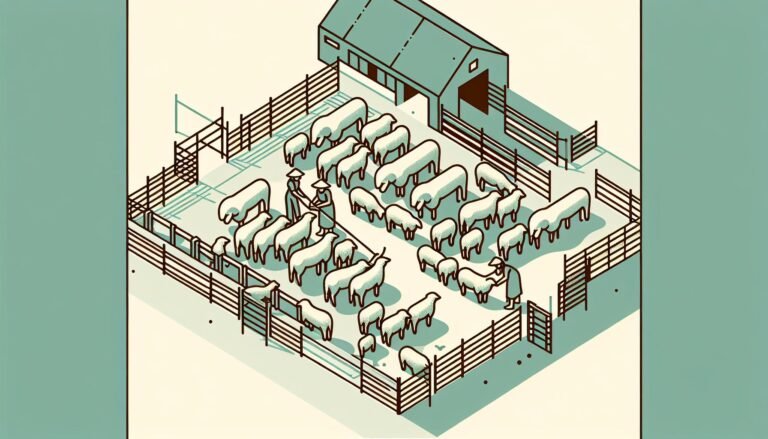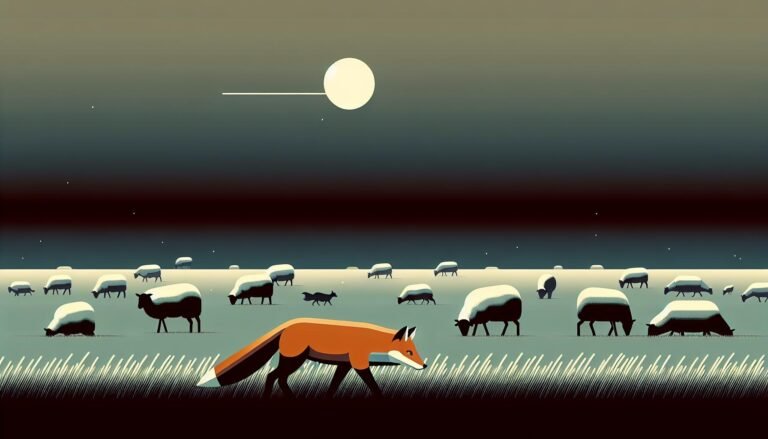Decoding Affection: The Surprising Ways Sheep Express Love and Bonding
Ever wondered how sheep express their affection? Well, I’ve spent years studying these fascinating creatures and I’ve got some insights to share. Unlike dogs wagging their tails or cats purring, sheep have their unique ways of showing love and trust.
Key Takeaways
- Sheep are emotionally sophisticated animals. They communicate complex emotions using different means like body language, physical gestures, and forming social bonds within the flock.
- Readiness to express and receive affection is key to the wellbeing of sheep. Regular and genuine acts of love and care can contribute to their improved health and longevity.
- Body language is a primary form of communication in sheep. Important indicators of affection include flocking together, making eye contact, tilting heads towards familiar faces, and varying tail movements based on emotional state.
- Sheep exhibit physical gestures of affection that are crucial to their bonding process. These include huddling together, nuzzling and rubbing heads, making eye contact, and amiable tail wagging.
- Social bonds play a pivotal role in sheep expressing affection. Sheep thrive on companionship, forming tight social bonds within the flock, and showing empathy towards the emotional states of their companions.
- Understanding sheep’s unique communication methods and promoting positive, affectionate interactions can significantly enhance their overall wellbeing and open up new possibilities for improved sheep management practices.
The Importance of Affection in Sheep
Observing affection in sheep may seem like a simple ball game, but in reality, it goes way beyond mere playfulness. Sheep’s affection is not just an aspect of their personality—it’s their entire world.
For years, I’ve observed and interacted with sheep in their natural environment. This close contact brought me one surprising discovery: sheep are far more emotionally complex creatures than most people give them credit for.
One could compare sheep to a tightly woven fabric. It’s not merely about individual threads but how they intertwine and strengthen the entire piece. Similarly, sheep function best when their emotional needs are met, and this includes expressing and receiving love.
Sheep display their affection primarily through social interactions. They have a strong desire to be part of the flock and form close ties with select members. More importantly, they demonstrate a high degree of emotional intelligence. Sheep can detect, interpret, and respond to emotions not only of their fellow sheep but also of other species, including humans.
Sheep that receive regular affection are known to exhibit prosocial behavior. This in turn promotes greater cohesion within the flock. It’s quite a sight to behold: a harmonious group of sheep, each one secure in the knowledge that they are loved and valued by their companions.
Interestingly, affection also affects sheep’s health positively. Those that regularly receive affection appear healthier and live longer. However, it’s not just about the quantity of affection, but also the quality. Genuine love and care are cornerstones for proper sheep emotional welfare.
The world of sheep affection is a fascinating reality to delve into. It clearly illustrates that sheep are creatures of emotion just as much as they are creatures of instinct. How they express and receive affection is a testament to their intricate emotional lives, and understanding this can shed light on ways to enhance their welfare.
Body Language of Affection in Sheep
One of the intriguing aspects of sheep behavior is how they express affection through body language. Yes, sheep do communicate in their unique and subtle ways.
The primary form of affection is through social interactions. Sheep are remarkably social creatures, fascinated by the concept of belonging. You’ll often see them huddling together, sometimes even nuzzling or rubbing their heads against one another. These actions are crucial signals of bonding and mutual acceptance in the flock.
In addition to communal bonding, there’s an element of personal interaction. Ever noticed how sheep react to your presence? The ones familiar with you tend to approach. This behavior may range from them merely making eye contact, tilting heads towards you, or even coming closer for a friendly sniff. It’s important to remember these reactions are not necessarily an invitation for a petting session, rather it’s their way of showing trust and building an emotional connection.
Sheep also have a complex form of communication involving their tails. You’d be surprised by the amount of emotional content that can be passed through simple tail movements. A relaxed, hanging tail is a sign of contentment, yet a tightly curled tail may signal nervousness or fear. In contrast, a vigorously wagging tail often indicates excitement.
Of course, these behavioral cues can vary based on a sheep’s personality and its familiarity with the environment. But these nonverbal signals are the best tools we have to understand their emotional state and dynamics within the flock.
As we continue to explore the emotional lives of sheep in the latter sections, you’ll find that these social interactions play a pivotal role not just in their relationships but also in their overall health and well-being.
Physical Gestures of Affection in Sheep
When you think of interactions between sheep, you might visualize soft bleating or frolicsome head butting. But did you know that these are not mere expressions of playfulness, but manifestations of affection and communication?
Let’s explore some observable physical gestures that reflect affection among sheep. A fascinating one is the act of ‘huddling together’. Often misconceived as a defence tactic against predators, this collective action holds a greater meaning – illustrating a sheep’s deep-rooted emotional connection with the flock. Wrapped in the safety and warmth of the herd, this togetherness is evidence of their affectionate bond.
If you’ve been lucky enough to witness the ‘nuzzling and rubbing of heads’, you’ve seen a beautiful display of sheepish affection. It’s not entirely different from how humans express affection. Much like how we might hug or hold hands, sheep nuzzle and rub heads to show endearment. What’s more? These exchanges aren’t just reserved for their kind but extend to other species and humans too.
Have you ever noticed a sheep winking at you? No, they’re not mimicking a pirate! ‘Eye contact’ is pivotal in sheep language. They tilt their heads and lock eyes with you, demonstrating trust and building emotional bonds. As an observant sheep caretaker, you’d be touched to notice recognizable trust and affinity in these observant creatures’ eyes.
Finally, let’s talk about the ‘hrumph’—that’s just a fun term I came up with! It’s when sheep wag or flick their tails. While this could convey a multitude of meanings like alertness or irritation, a casual tail wagging, especially in the presence of a familiar person, often signals contentment and affection.
Over the years, my journey with these gentle creatures has taught me that they are much more emotionally evolved than they are given credit for. As a passionate animal enthusiast, understanding their language of love has been an incredibly rewarding experience. These gestures of affection are proof of their rich emotional lives and their capacity for affectionate bonds. Understanding these gestures is a step closer to improving sheep’s welfare and overall wellbeing.
Social Bonds and Affection in Sheep
In my years of dealing with sheep, I’ve found that social bonds are a crucial aspect of their lives. These bonds aren’t just about survival. They’re about emotional connection, a sense of belonging, and of course, affection.
Sheep are anything but solitary creatures. They thrive on companionship and they form tight social bonds. Affection is an essential part of these bonds and is expressed in different ways. From huddling together for warmth and safety to nuzzling and rubbing heads as a sign of friendship, sheep communicate love and connection nonverbally.
Observing interactions within a flock, you’d notice the strong bond that they share. They are especially close to their family units, often doing everything together. They eat together, rest together, and play together. This demonstrate their innate desire for social interaction and their instinct to express and receive affection.
Another fascinating aspect of sheep’s emotional behavior is their sensitivity to their flock’s emotions. They’re aware of the mood changes within the flock and react in a similar manner, showing a high degree of emotional synchrony. This empathy is a clear indication of their sophisticated social dynamics.
Building on these observations, it’s clear that affectionate interactions can be an important tool in promoting positive behavior among sheep. This insight is highly useful in improving their welfare and overall well-being. Establishing a routine of positive and affectionate interactions can help in nurturing their emotional health and reduce stress levels.
Whether it’s head rubs, nuzzles, or simply standing close, these gestures of affection between sheep aren’t just adorable to watch—they’re fundamental to their wellbeing. These insights prove that sheep’s social and emotional capacities are much more complex and deep than they’re often given credit for.
The understanding and application of these findings in sheep management can lead to increased animal welfare standards and could pave the way for advancements in livestock practices in the future.
Conclusion
So there you have it. Sheep aren’t just woolly creatures grazing in the fields. They’re social beings that value companionship and express affection in their unique ways. From huddling together to nuzzling and head rubbing, these gestures speak volumes about their emotional capacity. It’s clear that their emotional synchrony plays a crucial role in the flock’s well-being. Recognizing these signs of affection isn’t just fascinating – it’s a step towards improving animal welfare standards and enhancing our livestock practices. As we continue to learn about these intriguing animals, we’ll better cater to their emotional needs and foster a more humane approach to sheep management.







